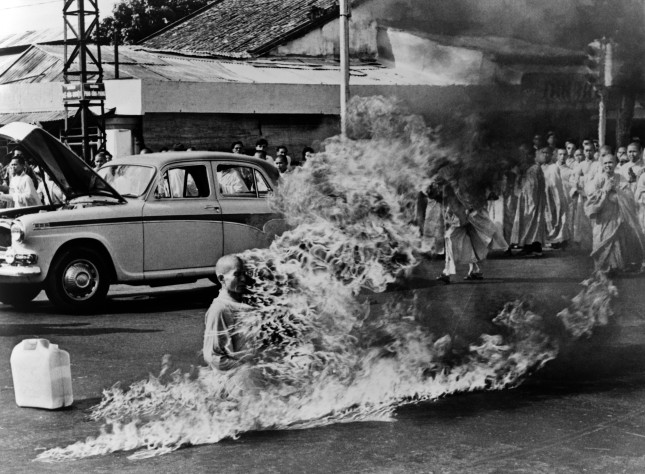Permit yourself to imagine.
Once accomplished, travel is unrestricted, borders nonexistent, walls breached.
How?
- Words
- Spray paint
- Lines of code
- Guitar
- Microphone
- Objet trouvé
- Dance
- March
- Screen print
- Sculpture
- Décollage
- Sticker bomb
- Banner drop
- Tree-sit
- Occupy
- Slingshot
- Molotov
- Barricade
- Arm-lock
- Film
- Gas mask
- Antacid and water
- Fiction
Dissent is fluid.
And the energy generated as it passes through a medium?
Consider the variables contained in oppression, impunity and greed.
Each element behaves like velocity, temperature and density and movement is inevitable.
Our expectations of art are disrupted—subverted.
Remember the Chilean arpilleras? A people’s history of tragedy, torture and Desaparecidos woven into tapestries by garment workers—Madres, Hermanas y Abuelas—under the brutal Pinochet regime.
Listen to the music of Pete Seeger. The power of protest is embodied in song. An iconic image of a working class man with an inscription in black text on his banjo, “This machine surrounds hate and forces it to surrender.”
Image and text by Barbara Kruger. Appropriate. Borrow. Reconfigure. In a haunting piece by the artist we are presented with the cropped décolletage of a woman, her neck and chin exposed and the text: “We will not become what we mean to you.”
Lauren Poitras is an Oscar and Emmy nominated documentary filmmaker and journalist. She produced, “My Country, My Country,” a film that exposed the turmoil caused by the occupation of Iraq by the United States military and the effect it had on both Iraqis and American soldiers. Poitras is consistently harassed by the Department of Homeland Security. Detained upon entry each time she returns to the U.S. from traveling abroad.
Journalists, Filmmakers, Artists and truth seekers—add them to the no-fly list, confiscate their electronics, surveil all communications.
Detain them. Intimidate them. Harass them to death. To “suicide.”
Like digital activist “hacker” Aaron Swartz?
Look at Kevin Carter’s, “Famine.”
The image of a starving Sudanese child on the ground with a hooded vulture standing sentinel in the background, netted the photojournalist a Pulitzer. Some time later, Carter drove to a favorite overlook—blue horizon and meditative rushing river drone—taped a hose to the exhaust pipe of his vehicle.
He died of carbon monoxide poisoning at 33.
For those haunted by experience and an excess of empathy, suicide may be a final rebellion.
Recall Thich Quang Duc immolating himself in protest of the Vietnam War?
A burning rage against the machinery of apathy.
In India, a quarter of a million farmers protested seed patents through suicide by ingesting pesticide supplied to them by Monsanto.
But is that Art?
The 2011 arrest on a trumped up tax charge and subsequent, temporary disappearance of Chinese artist, Ai Weiwei, had Western supporters mounting a full campaign for his immediate release.
#releaseaiweiwei trended on Twitter.
Soon after, inexplicably, numerous shattered dynastic vases and knock offs adorn the steps of historical Chinese landmarks and consulates in Western cities.
Dissent art is situational and represents the possibility of a crucial narrative, not new but suppressed.
We’ve been locked into a singular system, which serves official culture.
Flummoxed by alternative thinking, critical thought asphyxiates under the touch screen.
The forty-pixel finger navigating through a pop culture shock architecture, finds many connections and little substance.
Nadezhda Tolokonnikova of the feminist punk group, Pussy Riot begins her two-year sentence for her participation in the bands February 2012 protest song and performance at Christ the Saviour Cathedral.
While at Penal Colony 14, Tolokno goes on hunger strike, citing the inhuman conditions and slave labor practices of the colony. She smuggles a letter, which is published later online, detailing her treatment. She is disappeared while in transit to a new prison camp in Siberia.
A single human brain is capable of processing 37 petaflops of data, rounding up, that makes one quadrillion calculations, give or take, per second. So, knowing the variables make it—art—difficult to quantify.
Emerging science suggests that within the next 18 months there will be a network of supercomputers capable of five times that amount of processing.
Art must penetrate this confounding and subvert the official narrative.
Open the between space.
Alyce Santoro articulated the role of Art recently in her “Manifesto for the Obvious International.” She writes: “Drawing on art’s infinite possibilities, system-defying agents are re-humanizing, de-commodifying, and debunking all manner of contrived contraries by creating barter systems, cooperative workspaces, soup kitchens, food forests, and street libraries. In societies based on an ever-intensifying quest not for peace, health, or contentment, but for “progress” (broadly defined as the drive toward maximization of personal convenience, or what social ecologist Murray Bookchin called “the fetishization of needs”)—strategies for existence that are participatory, inclusive and nonhierarchical, and that encourage the sharing of skills, ideas and resources (the maximization of meaning), are eminently subversive.”
Caveat emptor.
Temptations are everywhere.
We accept these little concessions without reading the service agreement and relinquish control for convenience—security for a sense of belonging.
In his latest collection of “quasi-essays and docufictions,“Revolutionary Brain” writer and critic Harold Jaffe offers, “Possibly the hardest factor for concerned younger artists to accept is that there will always be an incommensurateness between their imaginative efforts and results. The primary obligation is to not avert your eyes: to bear witness.”
Writers, artists and activists must refute official narratives.
The artist/revolutionary creates new methods of engagement, informing the discourse with immediacy.
Artists are in a unique position to engage directly with the established value system, call it into question and mobilize against it.
If a distinction between commercial and activist art no longer exists, the medium(s) an artist uses no longer need be relegated to a single surface or conversation.
Subversion happens while viewing.
Walls disintegrate and become canvas.
The canvas extends beyond the inner city, barrio, border to the wild.
Courage of the imagining mind.
